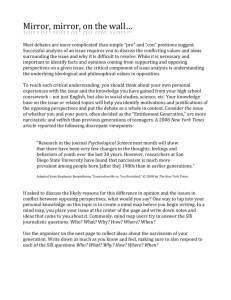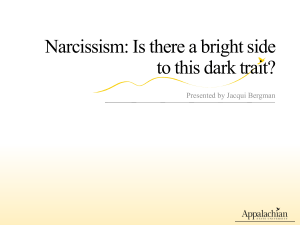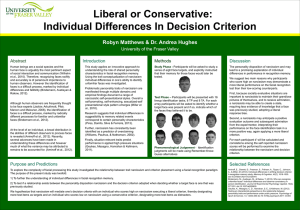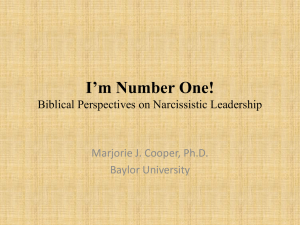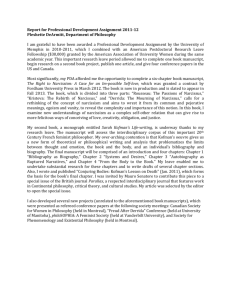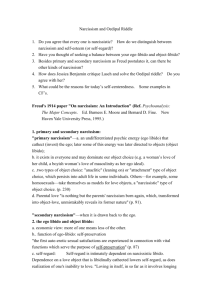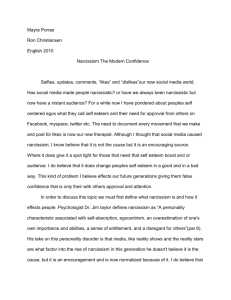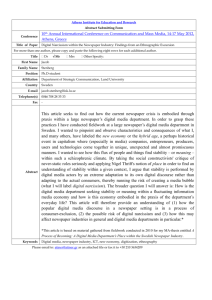Narcissism is on the rise Let's blame technology
advertisement
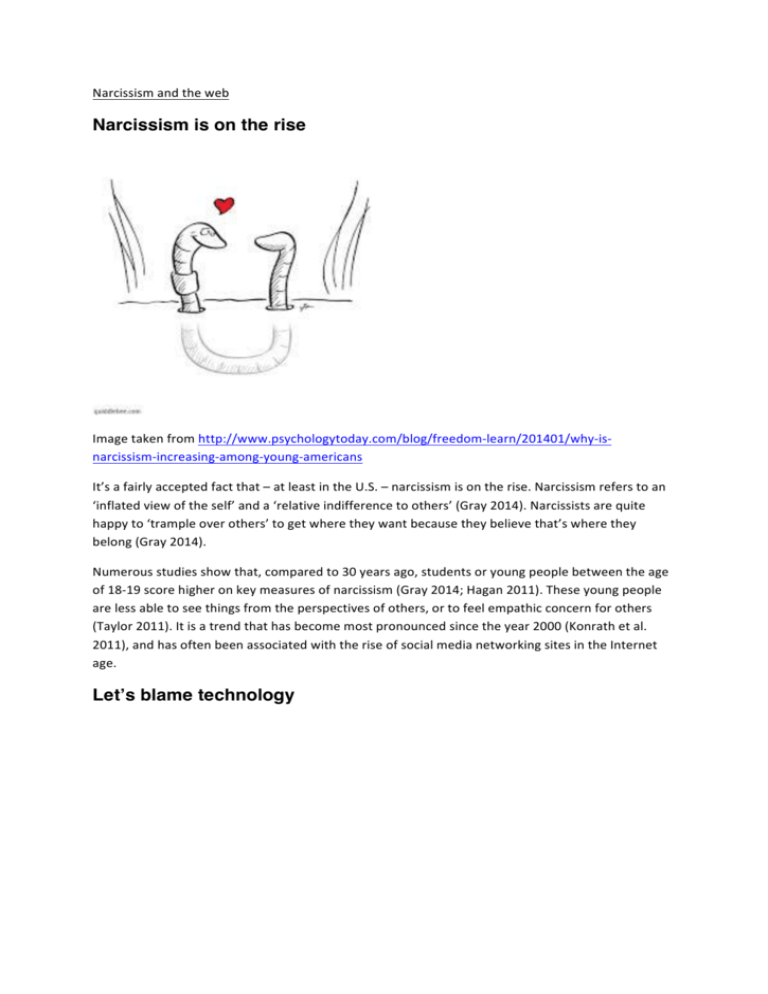
Narcissism and the web Narcissism is on the rise Image taken from http://www.psychologytoday.com/blog/freedom-­‐learn/201401/why-­‐is-­‐ narcissism-­‐increasing-­‐among-­‐young-­‐americans It’s a fairly accepted fact that – at least in the U.S. – narcissism is on the rise. Narcissism refers to an ‘inflated view of the self’ and a ‘relative indifference to others’ (Gray 2014). Narcissists are quite happy to ‘trample over others’ to get where they want because they believe that’s where they belong (Gray 2014). Numerous studies show that, compared to 30 years ago, students or young people between the age of 18-­‐19 score higher on key measures of narcissism (Gray 2014; Hagan 2011). These young people are less able to see things from the perspectives of others, or to feel empathic concern for others (Taylor 2011). It is a trend that has become most pronounced since the year 2000 (Konrath et al. 2011), and has often been associated with the rise of social media networking sites in the Internet age. Let’s blame technology Photo taken from http://bit.ly/1dLAOSu Many people have blamed technology – such as video gaming consoles, the Internet, and social media – for a general tendency towards antisociality in young people. The argument goes that young people are spending much more time fixed in front of computer screens than they ever used to, and so they are missing out on key social interaction opportunities – especially ‘play time’ with other children. Play amongst kids has been shown to be crucial in the development of key relationship skills such as the ability to listen to others, keep them happy and tolerate delayed gratification (Gray 2014). So how much has social media played a role in facilitating a new generation of narcissists, or is it simply a product of the times? Social media facilitates and rewards narcissism There’s no doubt that people spend a lot of time on social media, and the numbers are only increasing. In Australia, people spend an average 14 minutes per hour on social media (Morrison 2014). In 2004, Facebook had ~1 million users, and by 2011 this had increased exponentially to ~1 billion (Morrison 2014). More people from all age ranges are flocking to social media than ever before, and almost 90% of people between the ages of 18 and 29 use some form of social networking (Morrison 2014). Social networking sites surely facilitate narcissism in some ways. They are designed so that personal information or uploads like ‘selfies’ can be ‘liked’ instantly (providing immediate validation/reinforcement to the user). Their structure also lends itself to the superficial: on Twitter ‘tweets’ have a limit of 140 characters, while Facebook ‘hides’ statuses that are ‘overly’ long. The economical nature of statuses, tweets and photo uploads means that people interact with a shallow version of the user that can be extensively ‘tailored’ to impress. No evidence that social media CAUSES narcissism Yet there is no evidence to show that social media causes narcissism. Personality psychologists believe that personality is fairly well-­‐established by the age of 7 (Conger 2011), so it makes little sense to blame social media (Facebook, for instance, requires you to be 13 before you can sign up). Moreover, people with high scores on narcissism measures do not spend more time on Facebook, or update their statuses more often (Conger 2011). They do, however, use the site differently to others: to make as many friends as possible, and to carefully craft their profiles for impressive effect (Conger 2011). It seems most accurate to say that social media can facilitate narcissism, but not that it causes it. Many different experts from many different fields have weighed in on what may have caused the uprise in narcissism. In America, especially, a more permissive style of parenting has been blamed, as well as the popular move towards encouraging high levels of ‘self-­‐esteem’ (Conger 2011; Gray2014; Hagan 2011). Kids in the U.S. are increasingly being taught that they can have, should strive for – and deserve – whatever they want. Simply a product of the times? Perhaps, however, this is not just an isolated phenomenon, but more indicative of a cultural trend. The West is often defined by its ‘individualistic’ (rather than ‘communitarian’) societies that preference individual needs/desires over collective wellbeing. Although this has been spoken about as a more general cultural trend, it has important roots in neoliberalism, a political movement most associated with the Thatcher and Reagan eras in the U.K and U.S. respectively. Neoliberalism, especially from an economic perspective, seeks to make trade between nations as easy as possible. The basic principle of neoliberalism is to free up the movement of goods, resources and enterprises to find cheaper resources and maximise profits and efficiency (Shah 2010). Typically this has been accompanied by a reduction in public expenditure for social services, such as health and education, and the privatisation of public enterprise – including, for instance, the internet (Shah 2010). The logic is that this removes inefficiencies in the public sector – and that by deregulating industry and deunionising labor forces, ‘unnecessary’ impediments to capital mobility are removed, allowing greater movement of resources and thus further profit (Shah 2010). Such economically-­‐driven logic has a variety of political, social consequences. Pervading neoliberal ideology is the assumption that it is the individual, rather than the State, who should take responsibility for their wellbeing. This abdicates government from greater structural analysis of social inequities, and from providing effective, affordable healthcare. There is also the presumption that increasing profit for some benefits all – as in the concept of ‘trickle-­‐down wealth’. Yet in contemporary times, and in an increasing global economy, there is scant evidence that this is true. Half the population lives on under 2 dollars a day, and 86% of the world’s resources are consumed by the world’s wealthiest 20%. Under neoliberalism, growth has been immense for some, at the expense of most (Shah 2010). Conclusion It isn’t difficult then, to see the parallels between a society that values individualism and individual responsibility, and a society that promotes or condones narcissism. In the West, we are taught that democratic equality is equated with, and can be found in our free choice as consumers (Hedges 2014), or in our capacity to ‘be whatever we want to be, get wherever we want to get’. It is no surprise that this process rarely comes with empathic pause at who or what else is sacrificed in the process; anyone who celebrates their ‘good life’ in the neoliberal West is already engaging in a conscious ignorance of the global inequities that make that life possible. Coming soon… Part 2: The trend of neo-­‐liberalism in education and ‘individualised’ learning. Does student-­‐centred learning diminish the well-­‐being of the class as a whole? References Conger 2011. “Don’t Blame Facebook for the Narcissism Epidemic,” Discovery News. Accessed 25/3/14 at: http://news.discovery.com/tech/dont-­‐blame-­‐facebook-­‐narcissism-­‐epidemic-­‐110804.htm Gray 2014. “Why is Narcissism Increasing Among Young Americans?” Psychology Today. Accessed 25/3/14 at: http://www.psychologytoday.com/blog/freedom-­‐learn/201401/why-­‐is-­‐narcissism-­‐ increasing-­‐among-­‐young-­‐americans Hagan 2011. “New generation infected by narcissism, says psychologist,” Sydney Morning Herald. Accessed 25/3/14 at: http://www.smh.com.au/lifestyle/life/new-­‐generation-­‐infected-­‐by-­‐narcissism-­‐ says-­‐psychologist-­‐20110302-­‐1bewf.html Hedges 2014. “The Cult of Self,” Adbusters. Accessed 25/3/14 at: https://www.adbusters.org/magazine/112/cult-­‐self.html Konrath, S. H., O’Brien, E. H., and Hsing, C. 2011. “Changes in Dispositional Empathy in American College Studies Over Time: A Meta-­‐Analysis,” Personality and Social Psychology Review 15 (2), pp. 180-­‐198. Accessed 25/3/14 at: http://www.sitemaker.umich.edu/eob/files/konrathetal2011.pdf Kustoff and Spiro 2014. “Are You Ready to Deliver Personalized Learning?” Learning Solutions Magazine. Accessed 25/3/14 at: http://www.learningsolutionsmag.com/articles/1364/ Morrison 2014. “The Growth of Social Media: From Passing Trend to International Obsession,” SocialTimes. Accessed 25/3/14 at: https://socialtimes.com/the-­‐growth-­‐of-­‐social-­‐media-­‐from-­‐trend-­‐ to-­‐obsession-­‐infographic_b141318 O’Neill and McMahon 2005. “Student-­‐Centred Learning: What does it mean for students and lecturers?” AISHE readings: Emerging issues in the practice of University Learning and teaching. Accessed 25/3/14 at: http://www.aishe.org/readings/2005-­‐1/oneill-­‐mcmahon-­‐ Tues_19th_Oct_SCL.html Shah 2010. “A Primer on Neoliberalism,” Global Issues. Accessed 25/3/14 at: http://www.globalissues.org/article/39/a-­‐primer-­‐on-­‐neoliberalism Taylor 2011. “Narcissism: On the Rise in America?” Huffington Post. Accessed 25/3/14 at: http://www.huffingtonpost.com/dr-­‐jim-­‐taylor/narcissism-­‐america_b_861887.html
